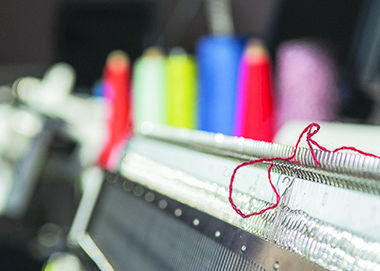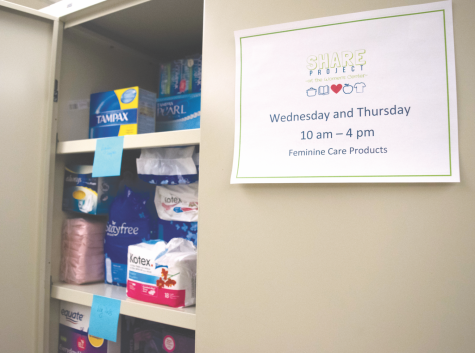Knitwear provides solace, style and sustainability

A strand of yarn on a knitting machine in the machine Knitting lab located in Rockwell hall on Tuesday, Feb. 10, 2015.
February 24, 2015
During these painfully cold and dragging months, sweater culture explodes. We’ve all watched this happen. When Mother Nature surprises us with a gust of below-freezing wind, we instinctually wrap up in the biggest chunky knit sweater, hat and scarf within arms reach. We love them. I nearly cry when I dare to walk outside without that extra layer. We need them. Our lives depend on them.
Why are these chunky gifts from the heavens so warm and comforting? The looped structure of knits forms air pockets in the fabric, which trap heat close to the body and block wind from passing through the complex, interwoven structure.
But we aren’t partial to the benefits of knitwear in just our sweaters. We cling to the comfort of our tightly constructed Lulu leggings, our casual American Apparel tees and all of the beanies, wool scarves and mittens that do their part to keep us warm and looking incredibly chill every single day. Our knits are our comfort blankets.
Coco Chanel is recognized for being the first to utilize jersey knits in women’s fashion after World War I. With this, she pioneered the road for women’s freedom from the restricting corset, inspiring all women’s sportswear designers to consider comfort along with style, thereafter.
Today, the desire to be comfortable almost single-handedly drives consumers’ choices. Designers latch on to this perceived necessity by continuing to innovate within the knitwear industry. Several spins on traditional sweaters floated down the runway last week at New York Fashion Week. Between street-inspired, distressed crew sweaters by Kanye West for Adidas and the elongated, preppy tennis sweater by Lacoste, knits are running wild.
But let’s back up for a second.
You might be wondering, does this technique use the same two needles that we saw our mothers, grandmothers and crafty friends with quick hands used to make kitschy gifts for every occasion? If this is true, and it takes me a month to knit a long rectangle (a.k.a. half a scarf), how can this be accomplished in mass production?
Take a walk up to the third floor of Rockwell Hall, and peak inside the Knitting Lab. What you see might shock you. Twenty home knitting machines — each containing 400 little latch hook needles — fill the classroom to max capacity. Fashion design students, like myself, manipulate these machines to innovate new techniques, expand our aesthetic horizons and produce fully-fashioned knit garments by the end of each semester.
On a much larger scale, industrial knitting machines produce probably about 100 sweaters a day. And with German and Japanese modern engineering supporting these massive sweater-makers, production is sure to be efficient and ecologically sound. These highly sophisticated machines provide a link between the designer’s independently creative mind and the physical product of their ingenuity.
While the benefits of knitwear are seemingly endless for both the designer and the consumer, there is one distinct asset that makes me swoon: Fully-fashioned knit garments create nearly zero waste.
Each piece of the garment is shaped on the machine — via complex programming or the manual transfer of stitches — so there is no excess material to be cut away. The garment is essentially made of one long yarn that is tightly looped around and through itself over and over again, until a perfectly shaped fabric piece is formed. And at the end of the garment’s life cycle, the yarn could ideally be unraveled and refurbished in order to enter the production cycle once again, thus creating the ultimate sustainable textile.
Next time you bundle up in your favorite chunky sweater, I hope you notice the intricate design and incomparable comfort of your knitted garments from now on. Knitwear is a prime example of science and art meeting in human engineering, creating something truly useful and beautiful.
Contact Ellen Freeborn at [email protected].























